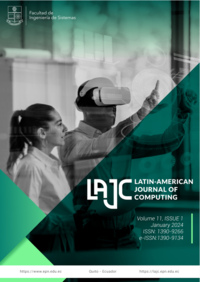Editorial
Keywords:
Editorial of the Issue 1 Volume 11 of Latin-American Journal of ComputingAbstract
The constant evolution of Computer Science challenges researchers to push the boundaries of innovation within a multidisciplinary landscape. From the Editorial of the Latin-American Journal of Computing, we are pleased to present to our readership this number, which showcases cutting-edge research in different applications of this field. The first article explores the application of Pappus-Guldin Theorems in solid modeling
using spline interpolation. Here, researchers demonstrate the potential of mathematical analysis in order to deliver more cost-effective computing-based solutions to possibly optimize industrial packaging design. Similarly, in the second article, numerical modeling is used to overcome the limitations of traditional approaches for analyzing linear elastic fracture mechanics by comparing the results obtained using commercial and open- source platforms.
Conversely, the work featured in the third article presents essentially non-oscillatory schemes for understanding the flow of two-phase fluids in oil extraction scenarios. Numerical methods are successfully employed to analyze mixing profiles of saturated water and petroleum fluids, demonstrating their importance for understanding fluid dynamics in porous materials. Likewise, the fourth article explores the usage of particle swarm optimization for enhancing the efficiency of a single-phase variable reluctance motor design. The authors demonstrate that minimizing copper losses is possible through finite element method analysis.
Addressing the evolving landscape of cybersecurity is the focus of the fifth article. The authors introduce a methodology for categorizing and updating attacks on web services, which contributes to a better understanding of vulnerabilities for preventing web-based attacks. In addition, the sixth article discusses the optimization of resource allocation on Cloud Computing by predicting traffic flow. The researchers employ machine learning models like ARIMA, Monte Carlo, and XGBoost for such predictive analysis.
Finally, the seventh and eight articles cover medical diagnosis and educational needs, respectively. In the former, an early-diagnosis method for Alzheimer's is featured using magnetic resonance imaging and the VGG16 Algorithm. The authors justify the effectiveness of employing AI to aid the diagnosis of such disease with a capacity
exceeding 82 per cent. In the latter, machine learning and text mining techniques are used to explore open educational resources (OER) for automatically identifying topics, enhancing their description and categorization.
In conclusion, the articles brought to you in this number provides a unique perspective to the different applications of Computer Science, and the dynamic nature of the research carried out in this contemporary discipline. Thanks to the authors who contributed to the ever-growing body of knowledge in this field, wishing them, and all our readers, a successful year 2024.
“Let science be the vessel to carry our dreams beyond the limits of our imagination”
Downloads
Downloads
Published
Issue
Section
License
Copyright Notice
Authors who publish this journal agree to the following terms:
- Authors retain copyright and grant the journal right of first publication with the work simultaneously licensed under a Creative Commons Attribution-Non-Commercial-Share-Alike 4.0 International 4.0 that allows others to share the work with an acknowledgement of the work's authorship and initial publication in this journal.
- Authors are able to enter into separate, additional contractual arrangements for the non-exclusive distribution of the journal's published version of the work (e.g., post it to an institutional repository or publish it in a book), with an acknowledgement of its initial publication in this journal.
- Authors are permitted and encouraged to post their work online (e.g., in institutional repositories or on their website) prior to and during the submission process, as it can lead to productive exchanges, as well as earlier and greater citation of published work.
Disclaimer
LAJC in no event shall be liable for any direct, indirect, incidental, punitive, or consequential copyright infringement claims related to articles that have been submitted for evaluation, or published in any issue of this journal. Find out more in our Disclaimer Notice.










